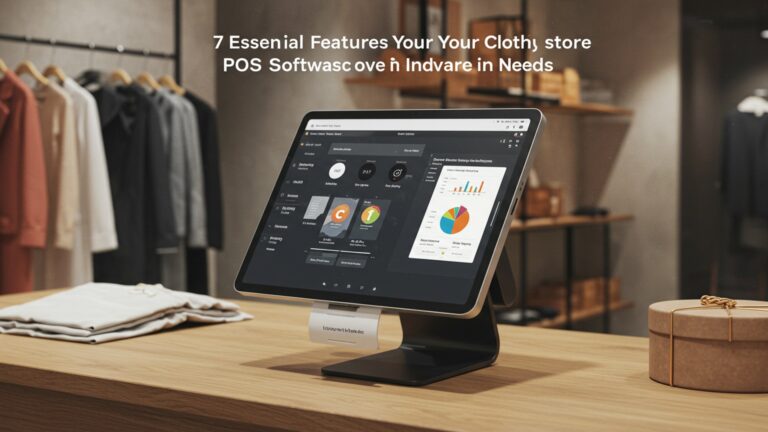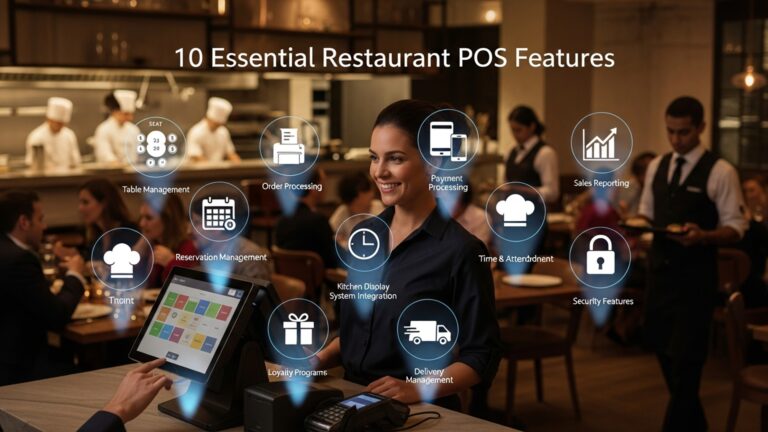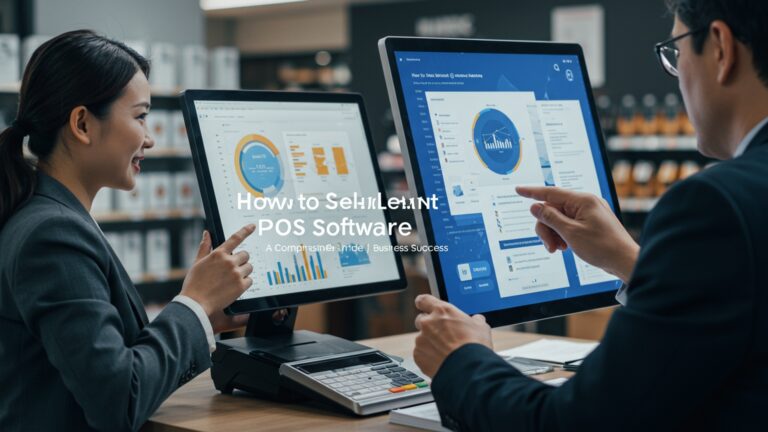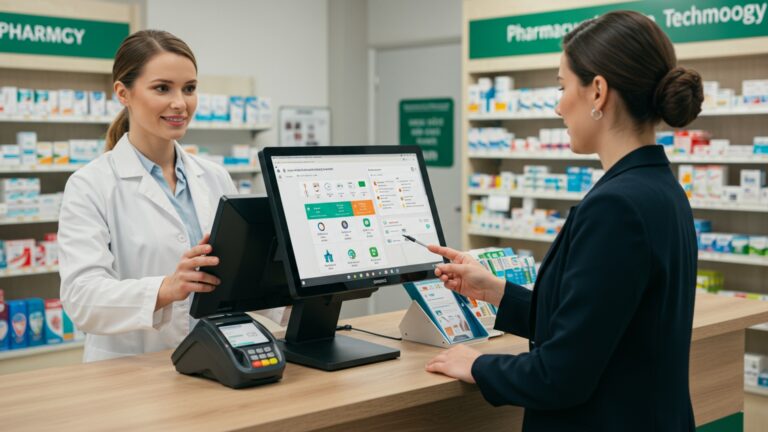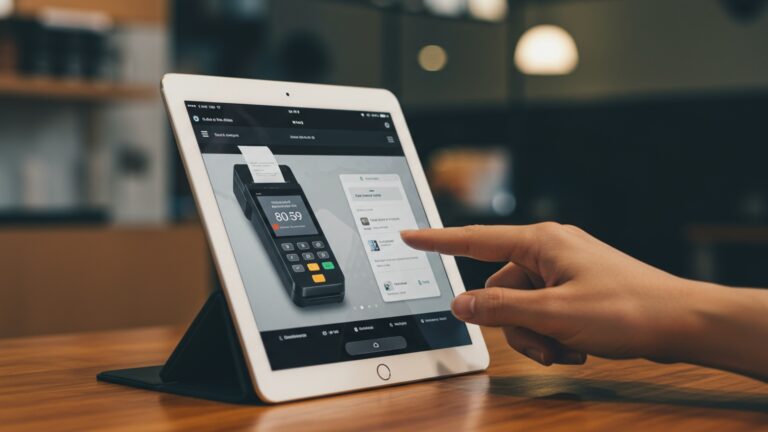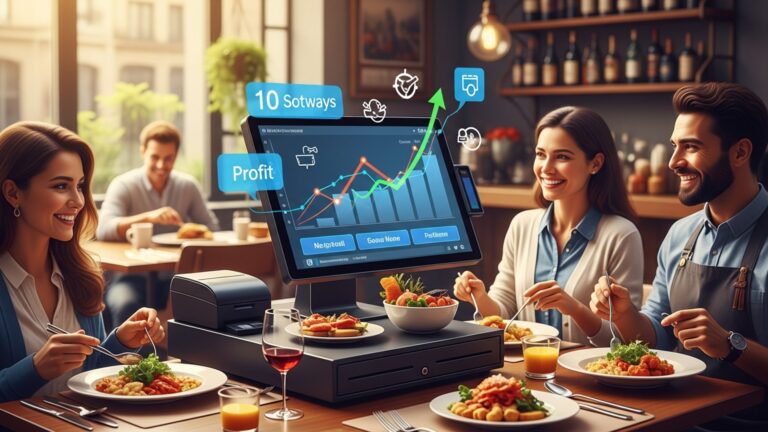The Essential Guide to Choosing POS Software for Retail Success
In today’s dynamic retail landscape, choosing the right pos software for retail transcends mere transaction processing; it dictates operational efficiency and customer experience. Retailers increasingly leverage advanced systems for real-time inventory synchronization across physical stores and e-commerce platforms, a critical trend highlighted by the surge in omnichannel shopping. Modern solutions offer AI-driven analytics, providing unprecedented insights into purchasing patterns and enabling personalized marketing campaigns, fundamentally shifting how businesses engage customers. From managing complex loyalty programs to facilitating seamless contactless payments and integrating mobile POS for pop-up shops, the strategic selection of robust software empowers agility and fuels sustainable growth, making it a cornerstone of contemporary retail success.

Understanding the Core of Retail: What is POS Software?
In the dynamic world of retail, the Point of Sale (POS) system is no longer just a cash register; it’s the central nervous system of your operation. At its heart, pos software for retail is a powerful application that allows businesses to process sales transactions, manage inventory, track customer data. gain invaluable insights into their performance. It’s the technology that empowers retailers to move beyond simple transactions and truly optimize their entire business ecosystem. Imagine a system where every sale, every return. every inventory update is seamlessly recorded and accessible, providing a comprehensive overview of your business health. That’s the power of modern POS software.
Historically, POS systems were standalone terminals. Today, the landscape has evolved dramatically, offering cloud-based, mobile. highly integrated solutions that cater to the diverse needs of small boutiques, multi-store chains. e-commerce businesses alike. Choosing the right pos software for retail can be the difference between merely surviving and truly thriving in a competitive market.
Essential Features: What Your POS Software Must Offer
When evaluating pos software for retail, a robust feature set is paramount. The right software should streamline operations, enhance customer experience. provide critical data for informed decision-making. Here are the non-negotiable features:
- Sales Processing & Transaction Management
- Inventory Management
- Customer Relationship Management (CRM)
- Reporting and Analytics
- Employee Management
- Integrations
This is the fundamental core. Your POS should handle various payment types (credit, debit, mobile, gift cards), process returns, exchanges, discounts. layaways efficiently. Speed and reliability at checkout are crucial for customer satisfaction.
Beyond merely tracking stock levels, advanced inventory features allow for real-time updates across all channels (in-store and online), automated reordering based on sales data, vendor management, multi-location inventory tracking. variant management (sizes, colors, styles). This prevents stockouts and overstocking, directly impacting profitability.
A powerful POS system helps you build lasting relationships. It should capture customer data (purchase history, contact info), facilitate loyalty programs, enable targeted marketing campaigns. personalize the shopping experience. Understanding your customers is key to repeat business.
This is where raw data transforms into actionable insights. Look for comprehensive reports on sales performance (by product, employee, time of day), inventory turnover, customer demographics. profit margins. Customizable dashboards allow you to monitor key performance indicators (KPIs) at a glance.
Track employee sales performance, manage commissions, clock-in/out functionality. assign different permission levels to staff. This ensures accountability and helps identify top performers.
A truly powerful pos software for retail doesn’t operate in a vacuum. It should seamlessly integrate with other essential business tools such as e-commerce platforms (Shopify, WooCommerce), accounting software (QuickBooks, Xero), marketing automation tools. shipping services. This creates a unified data flow and eliminates manual data entry.
Cloud-Based vs. On-Premise: Deployment Options Compared
The choice between cloud-based and on-premise pos software for retail is a critical decision that impacts cost, accessibility. maintenance. Understanding the differences is essential:
| Feature | Cloud-Based POS | On-Premise POS |
|---|---|---|
| Definition | Software hosted on remote servers, accessed via the internet. | Software installed and run locally on your hardware. |
| Accessibility | Access from anywhere, on any device with an internet connection. | Access limited to local network; remote access often requires VPN. |
| Cost Structure | Subscription-based (monthly/annual fees). Lower upfront cost. | Large upfront licensing fee. Ongoing maintenance/upgrade costs. |
| Maintenance & Updates | Managed by vendor; automatic updates, security patches. | Managed by retailer; requires IT staff or external support. |
| Data Security | Managed by vendor (often with robust security measures). | Managed by retailer; responsibility lies internally. |
| Scalability | Highly scalable; easy to add new users/locations. | Scalability can be complex and expensive. |
| Offline Mode | Many offer an offline mode for continued operation during internet outages. | Typically functions without internet. external integrations might fail. |
| Customization | Generally less customizable. flexible via integrations. | More potential for deep customization. at a higher cost. |
For most modern retailers, especially small to medium-sized businesses, cloud-based pos software for retail offers unparalleled flexibility, lower upfront costs. reduced IT overhead, making it the more popular choice. For instance, a boutique owner operating multiple pop-up shops would find a cloud-based system invaluable for managing inventory and sales across all locations in real-time.
Hardware Compatibility: Ensuring a Seamless Setup
Your chosen pos software for retail is only as effective as the hardware it runs on. It’s crucial to ensure seamless compatibility. While some POS vendors offer proprietary hardware, many support a range of third-party devices. Key hardware components include:
- POS Terminal/Tablet
- Barcode Scanner
- Receipt Printer
- Cash Drawer
- Payment Terminal (Card Reader)
This is your main interface. Tablets (like iPads or Android tablets) are popular for their portability and sleek design, especially with cloud-based systems. Traditional terminals offer robust, fixed setups.
Essential for quick and accurate product lookup and inventory management. Choose between 1D (linear) and 2D (QR codes) scanners based on your product labeling.
Thermal printers are common for their speed and quiet operation. Consider paper width and auto-cut features.
An integrated cash drawer that opens automatically upon transaction completion is a standard requirement.
Must be EMV compliant (chip card readers) and ideally support NFC (contactless payments like Apple Pay/Google Pay). PCI DSS compliance is non-negotiable for secure payment processing.
Before committing to any pos software for retail, verify its compatibility with your existing hardware or obtain a clear list of recommended hardware. This prevents costly surprises and ensures a smooth operational launch.
Scalability and Future-Proofing Your Retail Operations
Retail businesses are rarely static; they grow, adapt. evolve. Your pos software for retail must be able to keep pace. Choosing a scalable solution means it can easily handle increased transaction volumes, additional product lines, new store locations, or the expansion into e-commerce without requiring a complete system overhaul. Consider:
- Multi-Store Capabilities
- User Accounts and Permissions
- API Access
- Vendor’s Roadmap
If you plan to open more branches, can the software manage inventory, sales. employees across all locations from a central dashboard?
Can you easily add new employees and assign specific roles and permissions as your team expands?
Does the software offer robust APIs (Application Programming Interfaces) that allow for custom integrations with future tools or proprietary systems you might develop?
Research the vendor’s commitment to innovation. Do they regularly release updates, new features. adapt to evolving retail trends (e. g. , omnichannel selling, AI-driven analytics)?
A good example of future-proofing is selecting pos software for retail that inherently supports omnichannel selling. This means it can seamlessly connect your physical store sales with your online store, ensuring consistent inventory, customer data. pricing across all touchpoints. This is crucial as consumers increasingly expect a unified shopping experience.
Security Considerations: Protecting Your Business and Customers
In an era of increasing cyber threats, the security of your pos software for retail is paramount. You are handling sensitive customer data and financial details, making robust security measures non-negotiable. Look for solutions that offer:
- PCI DSS Compliance
- Data Encryption
- User Access Controls
- Regular Security Updates
- Backup and Disaster Recovery
This is a set of security standards designed to ensure that all companies that process, store, or transmit credit card details maintain a secure environment. Your POS system and payment processor must be compliant.
All sensitive data, both in transit and at rest, should be encrypted to prevent unauthorized access.
Granular permission settings ensure that employees only have access to the functions and data necessary for their roles, minimizing internal risks.
The vendor should consistently release updates and patches to address new vulnerabilities. For cloud-based systems, this is usually automatic.
Ensure the vendor has robust data backup procedures and a clear disaster recovery plan to protect your data in case of an outage or breach.
A retailer using a non-compliant or insecure POS system risks hefty fines, reputational damage. loss of customer trust. Prioritize security as a fundamental requirement when choosing pos software for retail.
Support and Training: The Backbone of Your POS Experience
Even the most advanced pos software for retail can become a source of frustration without adequate support and training. When issues arise – and they will – prompt and effective assistance is crucial to minimize downtime and prevent lost sales. Evaluate the vendor’s support offerings:
- Availability
- Support Channels
- Training Resources
- Reputation
Is support available 24/7, during business hours, or only via email? For a busy retail environment, 24/7 phone or chat support can be a lifesaver.
Do they offer phone, email, live chat, or a comprehensive knowledge base? A multi-channel approach is ideal.
Does the vendor provide onboarding, video tutorials, user manuals, or webinars? Proper training ensures your staff can efficiently use the system from day one.
Look at customer reviews and testimonials specifically regarding their support quality. A quick check on independent review sites like Capterra or G2 can provide valuable insights.
Think of a busy Saturday morning when your barcode scanner suddenly stops working. Having immediate access to technical support can prevent a queue from forming and keep your sales flowing. This level of support is invaluable for any business relying on pos software for retail.
Cost Analysis: Beyond the Sticker Price
The cost of pos software for retail isn’t just the initial purchase price or monthly subscription. A comprehensive cost analysis should include several factors:
- Software Subscription/Licensing Fees
- Hardware Costs
- Payment Processing Fees
- Setup and Installation Costs
- Training Costs
- Maintenance and Support Fees
- Integration Fees
For cloud-based systems, this is typically a monthly or annual fee, often tiered by features or number of terminals. On-premise solutions have a one-time license fee.
Terminals, scanners, printers, cash drawers, payment readers. These can be significant upfront investments.
These are transaction-based fees charged by your payment processor. interpret the rates, interchange fees. any monthly minimums. Some POS vendors offer integrated payment processing.
Some vendors charge for initial setup, data migration, or on-site installation.
While some basic training may be included, extensive custom training might incur additional fees.
For on-premise systems, ongoing maintenance and support contracts are common. For cloud, these are usually bundled into the subscription.
Connecting to third-party software (e. g. , accounting, e-commerce) might involve setup or ongoing fees from either the POS vendor or the third-party provider.
It’s crucial to get a detailed breakdown of all potential costs from each vendor. Don’t be afraid to ask for a full cost estimation for the first 1-3 years of ownership to get a realistic picture of your investment in pos software for retail.
Real-World Application: A Boutique’s Journey to Success
Consider ‘Fashion Forward,’ a local clothing boutique that struggled with manual inventory tracking and disjointed sales data. Their old cash register offered no insights. reconciling online sales with in-store stock was a nightmare, leading to frustrated customers and missed opportunities. By investing in a comprehensive cloud-based pos software for retail, they transformed their operations.
The new system provided real-time inventory updates, so when a customer purchased an item online, it was immediately removed from the store’s available stock. Loyalty programs were easily implemented, allowing Fashion Forward to track customer preferences and send personalized promotions, leading to a 15% increase in repeat business. The reporting features helped them identify their best-selling items, slow-moving stock. peak shopping hours, enabling more strategic purchasing and staffing decisions. This shift not only streamlined their daily tasks but also provided the actionable insights needed to grow their business significantly, proving the tangible benefits of choosing the right pos software for retail.
Conclusion
Choosing your POS isn’t merely selecting a tool; it’s architecting your retail future. My advice, honed from years observing diverse retail operations, is to resist the allure of endless features and instead, deeply grasp your unique operational rhythm. Prioritize solutions that seamlessly integrate with your existing workflows and growth ambitions. Consider how vital trends like cloud-based flexibility and mobile POS capabilities, which have become non-negotiable for dynamic retail environments, can empower your business. For instance, real-time inventory synchronization across online and physical stores, a critical recent development for true omnichannel success, can eliminate costly discrepancies and enhance customer satisfaction. Ultimately, a thoughtful investment here empowers you to deliver exceptional customer experiences, streamline operations. drive sustainable growth. Embrace this choice with confidence; your retail success depends on it.
More Articles
How to Leverage Cloud Based POS Software for Scalable Business Growth
Guide to Implementing Mobile POS Software for Flexible Business Transactions
Learn How POS Software Can Revolutionize Your Small Business Operations
Master Billing and POS Software Integration for Enhanced Business Efficiency
How to Streamline Your Billing with Effective POS Billing Software Solutions
FAQs
What exactly is a POS system and why is it such a big deal for my retail store?
A POS (Point of Sale) system is essentially the central hub of your retail operations. While it processes customer transactions, its capabilities extend far beyond that. It helps manage inventory, track customer data, generate detailed sales reports. even streamline employee management. It’s a big deal because a good POS system can dramatically improve efficiency, reduce errors, provide invaluable insights into your business performance. ultimately boost your bottom line.
What are the absolute must-have features I should look for in POS software?
When you’re evaluating options, definitely prioritize features like robust inventory management (including tracking stock levels, product variants. returns), integrated payment processing, customer relationship management (CRM) tools for loyalty programs and personalized offers, detailed sales reporting and analytics. multi-store capabilities if you have or plan to have more than one location. Don’t forget user-friendliness – your staff will be interacting with it daily!
Should I go for a cloud-based POS or one installed directly in my store?
That’s a key decision! Cloud-based POS systems offer more flexibility and accessibility; you can manage your data from anywhere, updates are often automatic. the upfront cost is usually lower (operating on a subscription model). On-premise systems give you more direct control over your data and hardware. might be preferred if you have very specific customizations or unreliable internet. For most modern retailers, especially smaller to medium-sized businesses, cloud-based is often the simpler, more scalable. cost-effective choice.
How crucial is it for my POS to play nice with other software I use?
It’s super crucial! Your POS system shouldn’t operate in isolation. Look for software that can integrate seamlessly with your existing tools, such as your accounting software (like QuickBooks or Xero), e-commerce platform (like Shopify or WooCommerce). any customer loyalty programs. Good integrations mean less manual data entry, fewer errors. a more holistic, accurate view of your entire business operations. It saves a lot of time and headaches.
What kind of investment am I looking at for new POS software?
The cost can vary quite a bit depending on the features, the vendor. whether you choose a cloud-based or on-premise system. Cloud systems typically have a monthly or annual subscription fee per terminal or user, ranging from tens to hundreds of dollars. On-premise systems might involve a higher upfront license fee plus ongoing maintenance. Always factor in hardware costs (like card readers, receipt printers, barcode scanners) and potential setup or training fees. Always get a clear, itemized breakdown of all potential costs.
What’s the typical process for getting new POS software up and running in my store?
First, you’ll select the right software and compatible hardware. Then comes data migration, which involves transferring your existing product inventory, customer lists. sales history into the new system. After that, you’ll configure the software to match your specific business rules, tax settings. payment options. Finally, thorough staff training is absolutely crucial to ensure everyone can use the new system confidently and effectively from day one. A good vendor will guide you through each step.
How can I make sure the POS software I pick won’t be outdated as my business grows?
To ensure longevity, look for a system designed with scalability in mind. This means it should easily handle an increase in product SKUs, customer volume. transaction numbers. Check if it supports multiple locations, additional users. regularly adds new features or integrates with emerging technologies. Cloud-based systems often have an advantage here, as providers frequently update and expand their offerings. Choose a vendor with a clear roadmap for future development and innovation.

